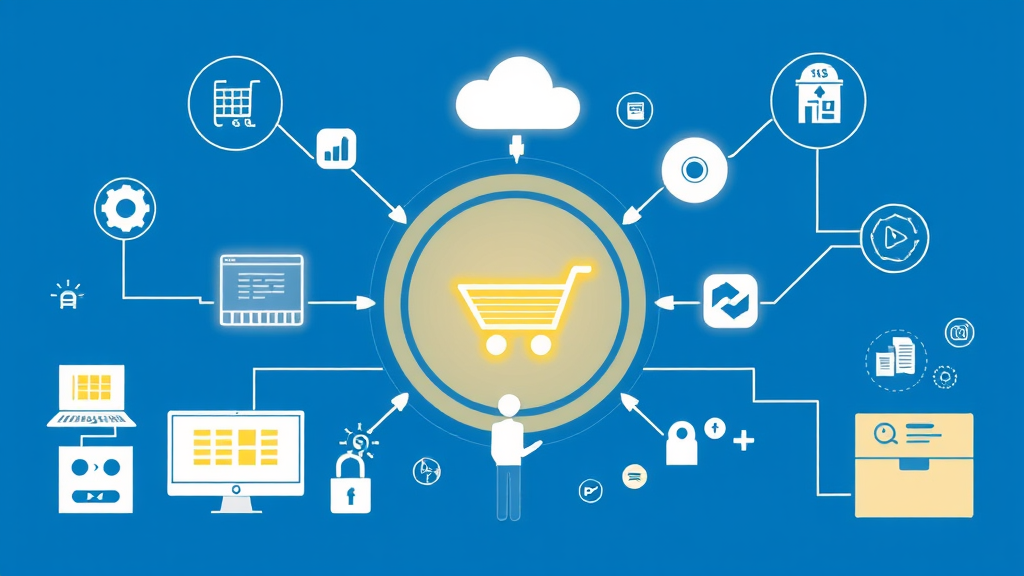Ecommerce automation is revolutionizing the way online businesses operate by streamlining processes, reducing manual labor, and enhancing customer experiences. By implementing automation tools, businesses can improve efficiency, reduce costs, and scale operations effectively. This blog post explores the various facets of ecommerce automation, its benefits, and practical applications.
Key Findings
- Enhanced Efficiency: Automation reduces manual tasks, allowing businesses to focus on strategic growth.
- Cost Reduction: Streamlining processes minimizes labor costs and operational inefficiencies.
- Improved Customer Experience: Faster responses and error-free operations result in a smoother shopping experience for customers.
- Scalability: Automation supports growth by managing increased workloads without requiring proportional increases in resources.
- Data-Driven Insights: Automation tools provide analytics, helping businesses make informed decisions.
Understanding Ecommerce Automation: Definition and Importance
Ecommerce automation involves utilizing technology to streamline and optimize various tasks within an online business, such as order processing, inventory management, customer communication, and marketing campaigns. By automating these repetitive processes, businesses can enhance efficiency, reduce errors, and allocate more time to strategic initiatives.
Key Benefits of Ecommerce Automation
-
Time and Cost Savings: Automating manual tasks like data entry and inventory updates frees up valuable time and reduces operational costs.
-
Enhanced Customer Experience: Automation enables timely order confirmations, shipping updates, and personalized product recommendations, leading to higher customer satisfaction and loyalty.
-
Scalability: As businesses grow, automation allows them to handle increased demand without a proportional increase in resources, facilitating efficient scaling.
-
Reduced Errors: By minimizing human intervention in processes like order fulfillment and inventory management, automation decreases the likelihood of errors that can impact customer satisfaction.
Implementing ecommerce automation not only streamlines operations but also positions businesses for sustainable growth and improved customer engagement.
External Sources: Learn More
Key Areas of Ecommerce Automation: From Inventory Management to Customer Service
Ecommerce automation streamlines various business processes, enhancing efficiency and customer satisfaction. Key areas where automation plays a pivotal role include:
Inventory Management
Automated inventory systems provide real-time stock updates, synchronize inventory across multiple sales channels, and trigger low-stock alerts. This ensures optimal stock levels, preventing both stockouts and overstocking.
Order Processing
Automation in order processing streamlines the workflow from order receipt to shipping. Tasks such as order confirmation, shipping label generation, and tracking updates are handled automatically, reducing errors and expediting fulfillment.
Customer Service
AI-powered chatbots and automated ticketing systems provide instant responses to common customer inquiries, offer 24/7 support, and efficiently route complex issues to human agents. This enhances customer satisfaction while reducing the workload on support teams.
Marketing Automation
Automated marketing tools enable personalized email campaigns, targeted promotions, and social media scheduling based on customer behavior and preferences. This ensures timely and relevant communication, fostering customer engagement and loyalty.
Data Analytics
Automated analytics tools collect and analyze data on sales performance, customer behavior, and website metrics. This provides valuable insights that inform decision-making and strategy optimization.
By implementing automation across these key areas, ecommerce businesses can enhance operational efficiency, reduce manual errors, and deliver a superior customer experience.
External Sources: Learn More
Transform your workflow and elevate your business—visit ipsom.io or email us at office@ipsom.io.
How Automation Enhances Customer Experience in Online Retail
Automation plays a pivotal role in enhancing the customer experience in online retail by streamlining operations and personalizing interactions.
Personalized Product Recommendations: By analyzing customer data, such as past purchases and browsing behavior, automated systems can deliver tailored product suggestions. This personalization makes customers feel valued and understood, leading to increased engagement and satisfaction.
Automated Customer Support: Implementing AI-powered chatbots enables businesses to provide instant responses to common customer inquiries, such as order status or product details. This 24/7 availability reduces wait times and ensures consistent support, enhancing the overall service experience.
Efficient Order Management: Automation in order processing ensures timely updates and accurate tracking information, keeping customers informed throughout their purchase journey. This transparency builds trust and confidence in the retailer's reliability.
Streamlined Returns and Refunds: Automated systems can handle returns and refunds efficiently, reducing processing times and minimizing errors. This leads to a smoother post-purchase experience, increasing customer satisfaction and loyalty.
Real-Time Order Tracking: Providing customers with up-to-date information on their order status through automated tracking systems enhances transparency and trust. Customers appreciate being informed about their purchases, which contributes to a positive shopping experience.
By integrating these automated solutions, online retailers can create a more seamless, efficient, and personalized shopping experience, ultimately fostering greater customer satisfaction and loyalty.
External Sources: Learn More
Implementing Marketing Automation: Strategies and Tools for Success
Implementing marketing automation in e-commerce involves leveraging technology to streamline and enhance marketing efforts, leading to increased efficiency and improved customer engagement. Below are key strategies and tools to consider for successful marketing automation:
1. Abandoned Cart Recovery
Approximately 70% of online shopping carts are abandoned before purchase. Automated emails targeting these customers can recover lost sales.
2. Personalized Product Recommendations
Utilizing customer data to suggest products based on browsing and purchase history can enhance the shopping experience and boost sales.
3. Multi-Channel Marketing Automation
Engaging customers across various channels—email, SMS, push notifications, and social media—ensures consistent messaging and maximizes reach.
4. Customer Segmentation
Dividing your customer base into segments based on behavior, demographics, or purchase history allows for more targeted and effective marketing campaigns.
5. Automated Cross-Selling and Upselling
Encouraging customers to purchase related or higher-end products through automated suggestions can increase average order value.
6. Loyalty Programs
Automating rewards and incentives for repeat customers fosters loyalty and encourages continued engagement.
Essential Marketing Automation Tools
Selecting the right tools is crucial for effective implementation. Here are some notable options:
| Tool | Features | Best For |
|---|---|---|
| Klaviyo | Email and SMS marketing automation, customer segmentation, personalized campaigns | Businesses seeking data-driven marketing strategies |
| Omnisend | Multi-channel marketing automation, including email, SMS, and push notifications | E-commerce businesses aiming for integrated marketing across multiple channels |
| ActiveCampaign | Combines email marketing automation with CRM and lead scoring | Businesses looking to nurture leads and build lasting customer relationships |
| Mailchimp | User-friendly email marketing platform with automation features | Small to medium-sized businesses starting with marketing automation |
| Brevo | All-in-one CRM with email, SMS marketing, and chat features | Businesses needing lead scoring and small-scale campaigns |
Implementing these strategies and tools can significantly enhance your e-commerce marketing efforts, leading to increased efficiency, higher customer engagement, and improved sales performance.
External Sources: Learn More
Transform your workflow and boost growth—visit ipsom.io or connect with us at office@ipsom.io.
Overcoming Challenges in Ecommerce Automation: Best Practices and Solutions
Implementing ecommerce automation can significantly enhance operational efficiency and customer satisfaction. However, businesses often encounter several challenges during this process. Addressing these challenges with best practices and effective solutions is crucial for successful automation.
Integration Difficulties
Integrating new automation tools with existing systems can be complex and time-consuming. Disparate platforms may lack standardized protocols, complicating seamless connections. To overcome this, select automation tools that offer robust integration capabilities or utilize middleware solutions to bridge gaps. Thorough testing before deployment ensures smooth interoperability.
Data Management Concerns
Centralizing data from various sources requires meticulous planning to maintain coherence and consistency. Poor data management can lead to inaccuracies, affecting decision-making and customer experiences. Implementing a comprehensive data management system that integrates seamlessly with your ecommerce platform can address this issue. Automating data collection and regularly updating records help ensure accuracy and relevance.
Security and Compliance Risks
Automated data handling increases exposure to security vulnerabilities and compliance challenges. Ensuring robust security measures and adherence to data protection regulations is essential. Regular audits and updates to security protocols can mitigate risks associated with data breaches and non-compliance.
Over-Automation
Excessive automation can make a business appear impersonal, potentially alienating customers. Maintaining a balance between automated processes and human interaction is vital. Use automation for repetitive tasks but ensure personalized communication in customer support and complex inquiries to preserve a human touch.
Resistance to Change
Employees may resist adopting new technologies, fearing job displacement or increased complexity. To address this, provide comprehensive training and clearly communicate the benefits of automation. Involving staff in the transition process can foster acceptance and ease the integration of new systems.
Cost and Complexity
The initial investment and complexity of setting up automation can be daunting. Starting with affordable tools that scale with your business allows for manageable implementation. Focus on automating high-impact areas first, then gradually expand to more complex tasks as your business grows.
By proactively addressing these challenges with strategic planning and best practices, businesses can effectively implement ecommerce automation, leading to improved efficiency and enhanced customer experiences.
External Sources: Learn More
Transform your marketing game—start automating with ipsom.io or get in touch at office@ipsom.io.
Future Trends in Ecommerce Automation: What to Expect in the Coming Years
E-commerce automation is rapidly evolving, with several key trends poised to reshape the industry in the coming years.
Artificial Intelligence (AI) and Machine Learning
AI and machine learning are enhancing personalized shopping experiences by analyzing customer data to offer tailored product recommendations and dynamic content. These technologies also power chatbots and virtual assistants, providing real-time customer support and streamlining service operations.
Headless Commerce
Headless commerce decouples the front-end presentation layer from the back-end commerce functionality, allowing businesses to update customer-facing experiences without disrupting backend operations. This architecture offers flexibility, enabling the creation of customized designs and layouts for different endpoints.
Predictive Analytics
Predictive analytics utilizes AI to forecast demand, optimize inventory management, and enhance customer service. By analyzing patterns, businesses can anticipate market trends, allocate resources efficiently, and improve customer satisfaction.
Voice Commerce
The rise of voice assistants like Amazon Alexa and Google Home is making voice-enabled shopping more prevalent. Consumers can use voice commands to search for products, place orders, and manage shopping lists, offering a hands-free and efficient shopping experience.
Augmented Reality (AR) and Virtual Reality (VR)
AR and VR technologies are transforming online shopping by allowing customers to visualize products in their environment before making a purchase. This immersive experience enhances customer engagement and reduces return rates.
Sustainable E-Commerce Practices
Sustainability is becoming a significant focus, with businesses adopting eco-friendly practices such as sustainable packaging and carbon-neutral shipping options to meet consumer demands and reduce environmental impact.
These trends indicate a future where e-commerce automation leverages advanced technologies to create more personalized, efficient, and sustainable shopping experiences.
External Sources: Learn More
FAQ – Frequently Asked Questions
What is ecommerce automation and why is it important?
Ecommerce automation involves using technology to streamline and automate repetitive tasks in online business operations, such as order processing, inventory management, and customer communications. This approach enhances efficiency, reduces manual errors, and allows businesses to focus on strategic growth initiatives.
Key Benefits of Ecommerce Automation:
-
Time and Cost Savings: Automating routine tasks frees up staff time and reduces labor costs, enabling employees to concentrate on higher-value activities.
-
Improved Customer Experience: Automation ensures timely order updates, personalized communications, and efficient customer support, leading to higher satisfaction and loyalty.
-
Scalability: Automated systems can handle increased workloads without the need for proportional increases in staffing, facilitating faster business growth.
-
Enhanced Data Accuracy and Decision-Making: Automation minimizes human errors and provides reliable data, supporting informed business decisions and improved analytics.
-
Efficient Inventory Management: Real-time inventory tracking prevents stockouts and overstock situations, optimizing order fulfillment processes.
Implementing ecommerce automation is crucial for businesses aiming to enhance operational efficiency, reduce costs, and provide superior customer experiences in a competitive online marketplace.
How can automation improve inventory management in ecommerce?
Automation enhances inventory management in e-commerce by improving accuracy, efficiency, and scalability. It reduces human errors, provides real-time stock updates, and streamlines order fulfillment. Automated systems also offer valuable insights for demand forecasting and cost reduction, enabling businesses to optimize stock levels and respond swiftly to market changes.
What are the benefits of automating customer service in online retail?
Automating customer service in online retail offers several key benefits:
-
Enhanced Efficiency: Automation handles routine tasks, allowing human agents to focus on complex issues, thereby improving operational efficiency.
-
24/7 Support: Automated systems like chatbots provide continuous assistance, ensuring customers receive support at any time, which boosts satisfaction and engagement.
-
Cost Reduction: By automating repetitive tasks, businesses can lower operational costs and reduce the need for additional staff, especially during peak periods.
-
Improved Customer Satisfaction: Faster response times and consistent service contribute to a more positive customer experience, leading to higher satisfaction and loyalty.
-
Scalability: Automated systems can easily scale to handle increased customer inquiries without the need for proportional increases in staff, facilitating business growth.
-
Consistency and Accuracy: Automation ensures uniform responses and minimizes human errors, providing reliable and accurate information to customers.
-
Data-Driven Insights: Automated tools collect valuable data on customer interactions, helping businesses identify trends and personalize future interactions.
Implementing customer service automation can lead to more efficient operations, cost savings, and enhanced customer experiences in online retail.
Which marketing tasks can be automated in an ecommerce business?
Ecommerce businesses can automate various marketing tasks to enhance efficiency and customer engagement:
-
Email and SMS Marketing: Automate campaigns such as welcome sequences, abandoned cart reminders, and personalized product recommendations to maintain consistent communication with customers.
-
Customer Segmentation and Personalization: Use data-driven insights to segment customers based on demographics, behavior, and purchase history, enabling targeted marketing strategies.
-
Social Media Management: Schedule posts, monitor engagement, and respond to inquiries automatically to maintain a consistent and engaging social media presence.
-
Chatbots and AI Customer Support: Deploy chatbots to provide instant responses to common customer inquiries, enhancing the customer experience and freeing up human resources for complex issues.
-
Lead Scoring and Nurturing: Automate the process of identifying and prioritizing potential customers based on their interactions and engagement levels, allowing for more effective follow-up strategies.
-
Retargeting Campaigns: Set up automated campaigns to re-engage visitors who have previously interacted with your site but did not complete a purchase, increasing conversion opportunities.
-
Content Marketing: Automate content creation, distribution, and promotion to attract and engage your target audience effectively.
-
Customer Feedback and Reviews: Automate the collection of customer reviews and feedback post-purchase to gather insights and build trust with potential buyers.
-
Dynamic Pricing: Adjust prices automatically based on factors like demand and competition to stay competitive and maximize profits.
-
Inventory Management: Automate tracking and managing inventory to prevent stockouts and overstock situations, ensuring efficient operations.
Implementing these automated marketing tasks can lead to improved operational efficiency, enhanced customer experiences, and increased sales for ecommerce businesses.
What challenges might businesses face when implementing ecommerce automation?
Implementing eCommerce automation offers numerous benefits but also presents several challenges:
1. Integration Difficulties: Connecting various systems like inventory management, CRM, and payment gateways can be complex due to differing data formats and APIs, leading to potential errors.
2. Data Management Concerns: Ensuring accurate, real-time data synchronization is crucial. Poor data management can result in issues like overselling or delayed shipments, harming customer trust.
3. Security and Compliance Risks: Automating processes increases exposure to data breaches. Adhering to regulations such as GDPR is essential to protect sensitive customer information.
4. High Implementation Costs: The initial investment for automation software, infrastructure, and training can be substantial, posing a barrier for smaller businesses.
5. Technical Glitches and System Failures: Automated systems are susceptible to technical issues, which can disrupt operations and lead to customer dissatisfaction.
6. Over-Reliance on Automation: Excessive dependence on automation without human oversight can result in errors, especially in complex or unexpected situations.
7. Resistance to Change: Employees may resist transitioning to automated systems due to fear of job loss or unfamiliarity, necessitating effective change management strategies.
Addressing these challenges requires careful planning, robust security measures, and ongoing staff training to ensure successful eCommerce automation implementation.
How does automation contribute to the scalability of an ecommerce business?
Automation enhances the scalability of an e-commerce business by streamlining operations, reducing manual labor, and improving efficiency. By automating tasks such as inventory management, order processing, and customer service, businesses can handle increased demand without proportionally increasing their workforce. This leads to faster order fulfillment, reduced errors, and improved customer satisfaction. Additionally, automation facilitates data-driven decision-making, allowing businesses to analyze customer behavior and market trends effectively. Overall, automation enables e-commerce businesses to scale operations efficiently while maintaining high service quality.
What are some popular tools for ecommerce automation?
Several tools can help automate various aspects of e-commerce operations:
-
Klaviyo: Specializes in email and SMS marketing automation, offering advanced segmentation and personalized campaigns.
-
Omnisend: Provides omnichannel marketing automation, integrating email, SMS, and push notifications to enhance customer engagement.
-
Mailchimp: Offers comprehensive marketing automation features, including email campaigns, audience segmentation, and A/B testing, suitable for small to medium-sized businesses.
-
Zapier: Connects various apps to automate workflows, enabling seamless integration between different e-commerce tools without coding.
-
Make (formerly Integromat): Allows creation of complex, customizable workflows between apps, providing flexibility for advanced automation needs.
-
Drip: Focuses on e-commerce marketing automation with features like behavioral tracking, personalized email campaigns, and multichannel marketing.
-
Brevo (formerly Sendinblue): An all-in-one CRM suite that automates marketing tasks across email, SMS, and chat, supporting lead scoring and capture.
-
Keap (formerly Infusionsoft): Combines CRM and marketing automation, offering tools for contact management, lead tracking, and automated marketing campaigns.
-
ActiveCampaign: Provides a suite of automation tools for personalized customer experiences, including email marketing, customer segmentation, and CRM integration.
-
HubSpot: Offers a comprehensive CRM platform with inbound marketing and workflow automation features, suitable for growing e-commerce businesses.
These tools can help streamline marketing efforts, improve customer engagement, and enhance overall operational efficiency in e-commerce businesses.
How can automation enhance the customer experience in online shopping?
Automation enhances the online shopping experience by streamlining processes and personalizing interactions. Key benefits include:
-
Personalized Recommendations: Utilizing customer data, automation tools suggest products tailored to individual preferences, increasing engagement and sales.
-
24/7 Customer Support: AI-powered chatbots provide instant responses to common inquiries, ensuring continuous assistance and reducing wait times.
-
Efficient Order Tracking: Automated systems keep customers informed about their order status, enhancing transparency and trust.
-
Automated Email Communications: From personalized onboarding to check-ins, automated emails maintain consistent engagement, fostering customer loyalty.
-
Self-Service Options: Automation enables features like self-scheduling and comprehensive FAQs, empowering customers to resolve issues independently.
By integrating these automated solutions, online retailers can offer a more efficient, personalized, and satisfying shopping experience.
What future trends are expected in ecommerce automation?
E-commerce automation is rapidly evolving, with several key trends shaping its future:
1. AI-Driven Personalization
Artificial Intelligence (AI) enables e-commerce businesses to analyze customer data, such as purchase history and browsing patterns, to deliver highly personalized shopping experiences. This includes tailored product recommendations and dynamic content that adapts to individual preferences.
2. Voice Commerce
The rise of voice-activated assistants like Alexa and Google Assistant is transforming shopping behaviors. Consumers increasingly use voice commands to search for and purchase products, prompting businesses to optimize their platforms for voice search and transactions.
3. Advanced Data Analytics and AI
Predictive analytics and AI are enhancing demand forecasting, inventory management, and customer insights. By analyzing historical data and customer behavior, businesses can optimize operations and personalize marketing strategies.
4. Sustainable Automation
As environmental concerns grow, e-commerce companies are adopting eco-friendly automation solutions. This includes using energy-efficient robots, sustainable packaging, and green logistics practices to reduce their carbon footprint.
5. Integration of Augmented Reality (AR) and Virtual Reality (VR)
AR and VR technologies are providing immersive shopping experiences, allowing customers to visualize products in their environment or try them on virtually. This reduces uncertainty and enhances customer engagement.
6. Hyper-Automation
Combining Robotic Process Automation (RPA) with AI and machine learning, hyper-automation streamlines complex business processes across supply chain management, customer service, and marketing, leading to increased efficiency and reduced errors.
7. Enhanced Customer Support with AI Chatbots
AI-powered chatbots and virtual assistants are revolutionizing customer service by providing instant responses, handling common inquiries, and offering personalized recommendations, thereby improving the overall shopping experience.
These trends indicate a future where e-commerce automation focuses on personalization, efficiency, sustainability, and enhanced customer engagement.
Is ecommerce automation suitable for small businesses?
Yes, eCommerce automation is suitable for small businesses. It streamlines operations by automating tasks like inventory management, order processing, and marketing campaigns, allowing small teams to focus on growth and customer engagement. Implementing automation can lead to increased efficiency, reduced errors, and enhanced customer experiences. However, challenges such as initial investment costs, integration complexities, and the need for technical expertise should be considered. Starting with automating simple, repetitive tasks and gradually scaling up can help small businesses effectively adopt eCommerce automation.





